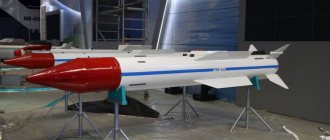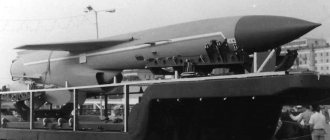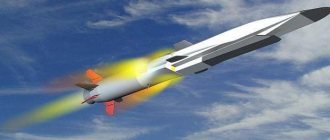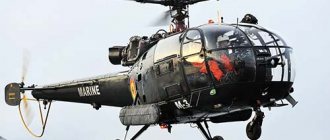Fish menu
In 1974, French military engineers created a medium-range cruise missile, which they named Exocet, after the flying fish, for its agility and ability to fly low over water. The “fish” turned out good and suitable. Therefore, it was immediately in great demand.
Argentina managed to grab the sea-to-sea class “fish” (Exocet MM-38) and almost managed to acquire a new air-to-sea class product: the French began selling the AM-39 “exocet” in 1979, without having had time to really test it. Their launch implied the use of French supersonic attack aircraft “Super-Etandar” - and the Argentine military just needed to capitalize the budget. As a result, without even haggling, they purchased 15 Super Étendard-Exocet tandems (according to some sources, 14), of which, however, they received only five. Why? Because it was 1981, a crisis was brewing in the South Atlantic, and the British put pressure on the French.
Like, who are you for anyway?!
Argentine Super Étendard in 1982 (photo source)
The French say nothing personal to them, we have a business. The British - no problem, then we will buy a large, large batch from you ourselves and make an advance payment. Just don't sell it in Peru either. Otherwise they will pretend that for themselves, and they themselves will tell the Argentines, we know these Latinos.
The Argentines, sensing something was wrong, became worried. They began to probe along the diplomatic line, and a technical delegation led by Captain Julio Perez was quickly sent to Aerospatial to exchange experience. In addition to the mustachioed forty-five-year-old warrior (albeit with a doctorate in engineering), it included two young trainees from the Puerto Belgrano military base - Antonio Schucht and Luis Torelli... But the French did not take them seriously, they talked down to them: the third world, where are they with the pork snout into subtle technologies. The Argentines didn't argue much. We just walked around, talked with colleagues in an informal setting - and got the hang of it.
Luis, Antonio and Captain Perez (photo source)
What exactly they wound up as a result became clear in June 1982.
“I blinded you from what happened...”
By that time, the Falklands War had entered a critical phase for Argentina, and Great Britain had lost the Sheffield type 42 guided missile destroyer and a bunch of expensive military equipment that was on board the Atlantic Conveyor container ship. The cargo ship itself, although it did not sink, was put out of action for a long time - thanks to the competent and creative use by the Argentines of those same air-sea “exocets” that the French did not supply to them.
On the same topic
Hit Gibraltar: how the loudest sabotage in the history of Argentina went wrong
The specialists from the country of tango and mate turned out to be not so simple and primitive. On their own, with virtually no help from the manufacturer and in just 45 flight hours, they figured out how to mount, calibrate and activate the “flying fish” on French planes, and also found a way to refuel attack aircraft in the air and thereby increase their range.
One way or another, the Argentines were sorely lacking in weapons, and the British fleet was diligently shelling the coastal fortifications of Soledad Island near Fort Stanley (aka Puerto Argentino).
...And then Captain Julio Perez, already known to us, appears on the scene and his brainchild - PUZhiP (ITB): literally “a launcher made of acorns and sticks”, which made it possible to launch “flying fish” MM-38 (with them the situation was a little better than with AM-39) from land. It was assembled from components that were easy to find in an ordinary ship's workshop.
Perez's invention on a street in Puerto Argentina (photo: Terence Laheny)
The installation turned out to be bulky and unglamorous, although the acorns and sticks looked generally menacing. The “native” computer remained on the Guerrico corvette (there was no time to transport and adapt it), and in the end the launcher looked like this: a double container with missiles, an inertial platform with all sorts of gyroscopes and compasses, a cart on which the “exocets” were mounted , cast iron for the wheels (so that it doesn’t take an hour to move away), a guidance system - and a gasoline-powered generator to somehow get it all going.
The six-ton platform ran on radio tubes, which, like during World War II, took forever to heat up.
But this doesn’t matter, the main thing is that everything works.
Links[edit]
- ^ab https://missilethreat.csis.org/missile/exocet/
- https://www.mbda-systems.com/product/exocet-mobile-coastal-defence-system/
- ^ ab Guillot, Jean; Estival, Bernard (1988). L'extraordinaire aventure de l'Exocet
(in French). Brest: Les editions de la Cité. ISBN 2-85186-039-9. The name of the rocket was given by M. Guillot, then technical director of Nord Aviation, after the French name for flying fish. - Harper, Douglas. "Exocet". Online Dictionary of Etymology
. - "Exocet AM.39/MM.40". Federation of American Scientists. August 10, 1999 Archived from the original on January 15, 2016. Retrieved December 9, 2022.
- Friedman, Norman (1994). Naval Manual of World Weapons Systems
(Updated Edition). Annapolis: Naval Institute Press. 109. ISBN 978-1-55750-259-9. In a recent Russian study on the effects of anti-ship missiles, missile boats required three hits to destroy a light cruiser and one to two hits for a destroyer or frigate. The Russian missile boats' anti-ship missiles have much larger warheads than the Exocet. - Friedman, Norman (1997). Naval Institute Handbook of the World's Naval Weapons Systems, 1997–1998. Naval Institute Publishing House. item 227. ISBN. 978-1-55750-268-1.
- MM38 was launched at the base of the ship. Only five of them were tested in 1973 from the Super-Felon helicopter, after which further development was abandoned in favor of the lighter and more compact AM39. — Pretty, Ronald T. (ed.). Jane's Weapons Systems 1976
(7th ed.). London, UK: MacDonald and Jane. item 133. ISBN. 978-0-35400-527-2. - Bolkcom, Christopher; Pike, John (1 April 1993). "Cruise Missiles: Another Breathing Threat." Combat Aircraft Proliferation: Issues of Concern. Federation of American Scientists
. Archived from the original on March 10, 2016. Retrieved February 10, 2009. - Rihanna
Scott, Richard (September 28, 2016).
"Chile begins modernization of MM40 Block 3 Exocet". IHS Jane 360
. Archived from the original on January 16, 2022. Retrieved January 14, 2022. - "Perú aprueba 41 million devices for protection and final version with MM-40 Exocet". Foro Naval Base
(in Spanish). December 20, 2010. Archived December 9, 2018. Retrieved December 9, 2022. - "Premiere Exocet MM40 Block3 missile in French". Mer et Marine
(in French). March 19, 2010. Archived from the original on March 22, 2010. Retrieved December 9, 2022. - Scheina, Robert L. (July 2003). The Wars of Latin America Volume II: The Age of the Professional Soldier, 1900-2001. Potomac Books Inc. Page 316 ISBN. 978-1-57488-452-4.
- ↑
Story about the attack. Archived December 12, 2007 at the Wayback Machine, page 6. - Loss of HMS Sheffield - Board of Inquiry (PDF) (Report). Northwood: Commander-in-Chief of the Fleet. May 28, 1982 p. 2. Archived from the original (PDF) on February 6, 2012. Retrieved December 9, 2022.
- ↑
Atlantic Conveyor - Before She Was Famous - Jump up
↑ Chant, Christopher (2001).
Air War in the Falkland Islands 1982
. Oxford: Osprey Publishing. paragraph 55. ISBN 978-1-84176-293-7. - "Commission of Inquiry (Report) Loss of the SS Atlantic Conveyor" (PDF). Archived from the original (PDF) on October 12, 2012. Retrieved November 25, 2012.
- "Prince Andrew speaks of Falkland Islands horrors". Glasgow Herald
. November 14, 1983 p. 2. - ^ abcd Lawrence Friedman; Lawrence (King's Friedman College London, University of London, UK); Professor of Military Studies Lawrence Friedman, Sir (2005). The Official History of the Falklands Campaign: War and Diplomacy. Psychology Press. p. 545. ISBN 978-0-7146-5207-8.
- ↑
Jerry Pook (June 15, 2008). RAF Harrier Land Attack: Falkland Islands. Feather and sword. p. 132. ISBN 978-1-84884-556-5. - ^ a b David Morgan (2007). Hostile skies. Phoenix. p. 240. ISBN 978-0-7538-2199-2.
- Ewan Southby Tailiour (2 April 2014). Exocet Falklands: The Untold Story of Special Forces Operations. Feather and sword. p. 238. ISBN 978-1-4738-3513-9.
- ^ ab Inskeep, Ian (2002). The Exocet Trial: HMS Glamorgan and the Falklands War, 1982
. Chatham. pp. 160–185. ISBN 1-86176-197-X. - "Royal Navy casualties, killed and died, 1980-89". Naval History Home Page
. Retrieved February 13, 2022. - Briley, Harold (May 2002). "The Story of John Nott". Falkland Islands Newsletter
(81). Archived from the original on November 22, 2010, operations around the world are remarkable and are being ensured to prevent further Exosai being bought by Argentina. I have authorized our agents to pose as bona fide buyers of equipment on the international market, ensuring that we will outbid the Argentines. Other agents identified Exocet missiles in various markets and secretly disabled them based on information received from the French. - Friedman, Lawrence (1 January 2005). The Official History of the Falklands Campaign: War and Diplomacy. Routledge. p. 380. ISBN 978-0-7146-5207-8.
- "A las Malvinas en subte". Page / 12
(in Spanish). March 25, 2012 archived from the original on November 15, 2022. Retrieved December 9, 2022. - ↑
Official investigation into the circumstances of the attack on USS Stark in 1987. - ↑
Leone, Dario (July 14, 2022).
"How a modified Iraqi Falcon 50 business jet nearly destroyed an American frigate". National interest
. Retrieved April 12, 2022. - ^ ab "Trade registers". SIPRI
. Archived from the original on January 31, 2011. Retrieved February 26, 2010. - "Latest News: Two Sigma 9113 Corvettes More for Indonesia" (PDF). Damen News
. No. April 7, 2006 Archived from the original (PDF) on October 1, 2006. Retrieved May 2, 2011. - "Malaysian Navy's first test of Scorpion launches Exocet missile". Brahmand.com
. August 4, 2010 archiving from the original on July 16, 2015. Retrieved December 9, 2022. - ↑
Engelbrecht, Leon (October 9, 2008).
"Fact File: Valor-class Frigates". DefenseWeb
. Archived from the original on March 20, 2016. Retrieved December 9, 2018. - Military balance
. International Institute for Strategic Studies. 2013. p. 531 ISBN. 978-1-85743-680-8. - "Refakat Ve Karakol Fi̇losu Komutanliği". Turkish Navy
(in Turkish). Archived from the original on March 23, 2010. Retrieved November 29, 2009. - "World Navies Today: Türkiye". Hazegray.org
. March 25, 2002, archived from the original December 19, 2009. Retrieved November 29, 2009.
No foreplay
The cart does not rotate around its axis, so they decided to immediately deploy the missiles delivered by the Hercules at a certain angle and wait until the evil English destroyer appeared in the reach quadrant, harassing the Argentine infantry. It remained to resolve the issue of software and converting data from the radar: to search for the target, they used a Westinghouse pulse-Doppler radar, whose format was very different from the one with which the PUZhP worked. Well, in battle, the “smart fish” required a lot of subtle manipulations over itself. Meanwhile, the enemy ship managed to change its location... and Captain Perez had no choice but to adjust the program “by eye.”
However, the captain had an eye - wow!
The launch protocol was developed to be no less brutal. In theory, it was as it should be: the on-board computer from the sea twice sent small data packets to the rocket (only 64 bits) and waited for it to return the signal in the same form. Without this, Exoset would not be activated. Only then was the operational information sent: distance, lift height, quadrant for searching for an alternative target and other parameters.
Exocet launcher (photo source)
In the absence of an on-board computer, Perez and his assistants decided to modify the original protocol: a “large” packet with data for the maximum search quadrant was simply sent to the “flying fish” three times in a row. Perez involved his own sons in soldering the wires cut as a result of “emergency dismantling” - and at about eight in the evening on May 31, 1982, the PUZhIP was ready for operation.
This is exactly what Perez meant when he crossed himself and said: “Everything is the will of God, senors.”
Indian magic
Then things didn't go well. An enemy ship almost immediately entered the desired quadrant. However, for a reason that remains unclear, the engine of the first rocket did not want to ignite. They began to prepare the second one, but in a hurry they miscalculated the trajectory and there was an undershoot.
... there were no missiles left for subsequent attempts. They were delivered only on the fifth of June and after that they waited for another week: every evening, as soon as it got dark, the PUZhIP was installed, and at dawn they were dismantled so that the British would not spot them. At night they peered intensely into the dark horizon... But there were still no English ships.
Rocket launch pad and electronics unit (photo source)
On the same topic
So-so struggle: why did the British drown at the Falklands?
The target was “managed” only on June 12, and in the literal sense. Participants in the events confirm that, with the permission of Captain Perez, junior officers from the northern provinces, where the traditions of the Quechua and Guarani Indians are still alive, actually performed something like a ritual dance with which peasants make rain during a drought.
Laughter and laughter, but they danced at half past three in the morning, and already at 3:15 the radar started beeping, because a target appeared at a distance of 29,960 meters - the destroyer Glamorgan with a displacement of 5,440 tons. The “fish” that had soared into the air spread out menacingly over the waves, and before the Argentine missilemen had time to catch their breath, a whitish glow spread in the distance: they were hit. The Exocet flew into the stern of the destroyer, burning down a helicopter standing in the hangar, killing 13 people and injuring 22. All on-board electronics were disabled, and if not for the immediate reaction of the watch officer Ian Inskip, who noticed the missile in time and managed to turn around, it would have hit the center of the hull and the destroyer would have sunk.
British destroyer after being hit (photo source)
Heritage
On the same topic
Falklands 2.0. What will happen if Argentina decides to return the islands?
Two days later the war ended with the surrender of Argentina, but the cause of Captain Perez did not die. Quite puzzled by the Argentine ingenuity, the British later used the idea of PUZhiP when developing the Excalibur coastal defense system and, in general, repeatedly mentioned that this incident in the Falklands forced them to radically reconsider the concept of tactical actions in a war at sea. And also be more attentive to potential opponents...
Julio Perez himself was demobilized with the rank of rear admiral and began teaching at the engineering faculties of the best universities in Argentina. He died in 2008, leaving behind several textbooks on higher mathematics. When asked in numerous interviews to comment on the PUZhiP story, Perez always answered: “I was just doing my job.”
External links [edit]
| Wikimedia Commons has media related to Exocet . |
| Look up Exocet in Wiktionary, the free dictionary. |
- Manufacturer's website (in English and French)
- Photo gallery of various Exocet rocket variants (in French)
- Argentine account of the exocet's role in the Falklands War (in English)
- Photos of Exocet damage on USS Stark (in English)
- Testing Exocet MM-40 Block 3 (in English)
- CSIS Missile Threat | Exocet (in English)
| Authoritative control |
|











